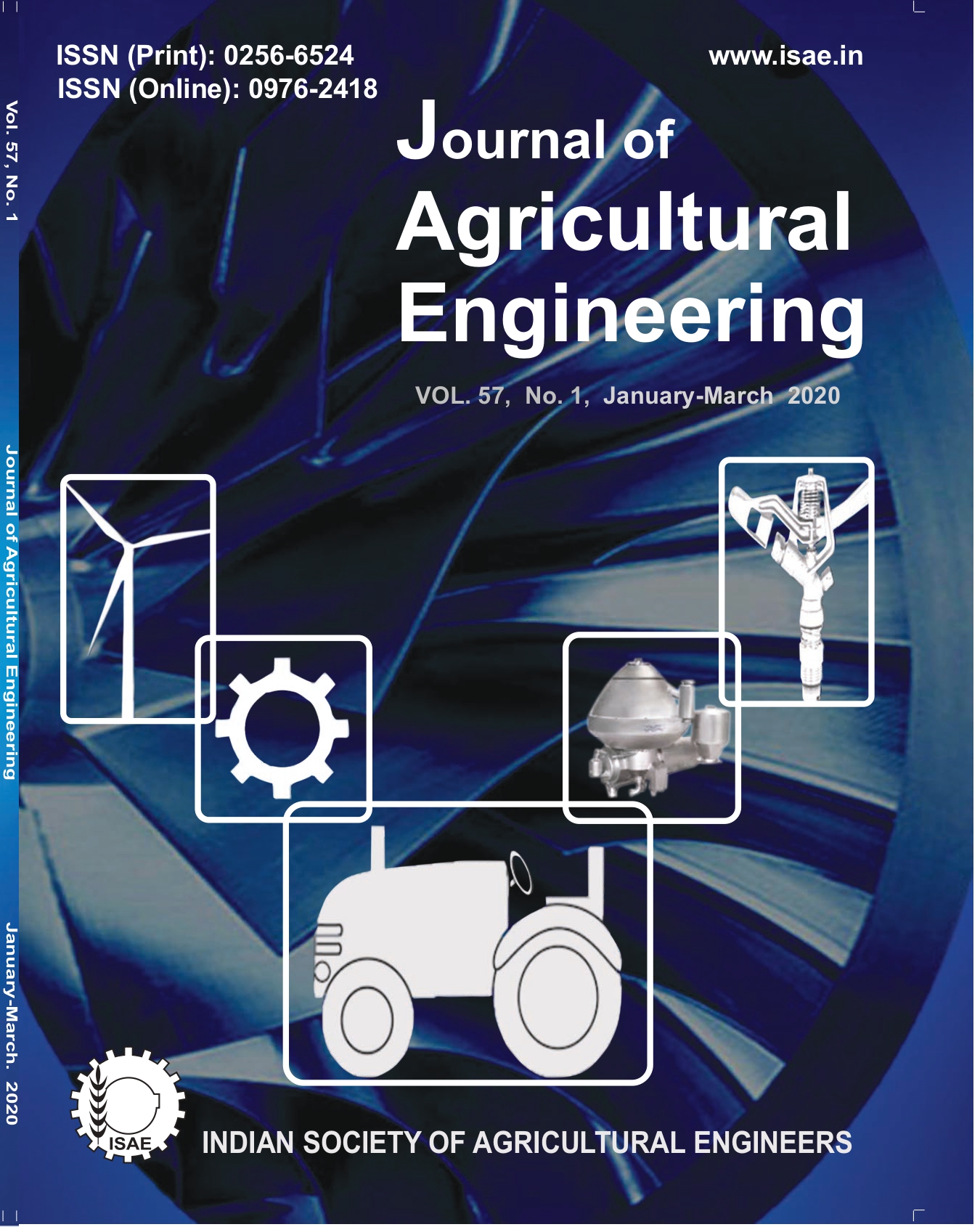Emitters and Filters Performance under Treated Sewage Water Reuse with Drip Irrigation
DOI:
https://doi.org/10.52151/jae2020571.1705Keywords:
Micro-irrigation, wastewater, filter, emitter, DTSW, emitter cloggingAbstract
An experiment was carried out under open field conditions on black cotton soil at Agriculture College, Nagpur to study the performance of different types of emitters and filters while using irrigation water of different qualities for different periods of operation. Eight treatments comprising of irrigation water quality as main treatment [domestic treated sewage water (DTSW) from a phytorid sewage treatment plant and deep open well water (WW)], sub-treatments comprising of emitter type (inline and online) and time of operation (60 h and 120 h) of drip system were planned. Gravel filter, followed by disk filter, was used to filter water of different quality. Partial clogging percentage of gravel filter was higher in case of DTSW. Emission uniformity coefficient decreased rapidly in DTSW compared to WW. Mean discharge reduction percentage was 13.23 % in gravel filter, and 18.72 % in disk filter. Emitter’s emission uniformity percentage in WW was better than in DTSW. The manual operation time (i.e. time interval between two consecutive maintenance events) for disk filter was shorter than gravel filter in both treatments. Domestic treated sewage water could be used for crop production with proper maintenance of filter, lateral and emitters.
References
APHA. 1985. Standard Methods for the Examination of Water and Wastewater. 19th Ed., American Public Health Association, Washington, DC, pp: 1262.
APHA. 2012. Standard Method for the Examination of Water and Waste Water. 22ndEd., American Public Health Association, Washington DC, pp: 1360.
ASABE. 1999. Field Evaluation of Micro Irrigation Systems. ASABE Standards EP 458, 46th Ed., American Society of Agricultural and Biological Engineers, St. Joseph, Michigan, USA, 792-797.
ASAE. 1996. ASAE Standards Engineering Practices Data. 43rd Ed., American Society of Agricultural Engineers, St. Joseph, pp: 864.
BIS. 2001. Method of Sampling and Test (Physical and Chemical) for Water and Waste Water, IS: 3025 (Part 51): Carbonate and Bicarbonate. Bureau of Indian Standard, New Delhi, pp: 10.
Capra A; Scicolone B. 2007. Recycling of poor quality urban wastewater by drip irrigation systems. J. Cleaner Prod., 15, 1529-1534.
Carr G; Potter R; Nortcliff S. 2011. Water reuse for irrigation in Jordan: Perceptions of water quality among farmers. Agric. Water Manage., 98, (5), 847-854.
EI-Tantaway M T; Matter M A; Arafa Y E. 2009. Filters and emitters performance under treated waste water. Misr. J. Agric. Eng., 26(2), 886-904.
Elgalla M; Fletcher L; Evans B. 2016. Assessment of potential risks associated with chemicals in wastewater used for irrigation in arid and semiarid zones: A review. Agric. Water Manage., 177, 419-431.
Evans R; Wu I; Smajstrala A. 2007. Micro-irrigation systems. In: Design and Operation of Irrigation Systems, 2nd Ed., Chapter 17, Am. Soc. Agric. Biol. Eng. Spec. Monogr., 632-683.
Gouider M; Bouzid J; Sayadi S; Montiel A. 2009. Impact of orthophosphate addition on biofilm development in drinking water distribution system. J. Hazard. Mater., 167, 1198-1202.
Han S; Li Y; Zhou B; Liu Z; Feng Ji; Xiao Y. 2019. An in-situ accelerated experimental testing method for drip irrigation emitter clogging with inferior water. Agric. Water Manage., 212, 136-154.
Kirnak H; Dogan E; Demir S; Yalcin S. 2004. Determination of hydraulic performance of trickle irrigation emitters used in irrigation system in the Harran Plain. Turk. J. Agric. For., 28(4), 223-230.
Lamm F R; Camp C R. 2006. Subsurface drip irrigation. Dev. Agric. Eng.,13, 473- 539.
Li J; Chen L; Li Y. 2009. Comparison of clogging in drip emitters during application of sewage effluent and groundwater. Trans. Am. Soc. Agric. Eng., 52(4), 1203-1211.
Li J; L Chen; Li Y; Yin J; Zhang H. 2010. Effect of chlorination schemes on clogging of drip emitter during application of sewage effluent. Appl. Eng. Agric., 26(4), 565-578.
Li J S; Li YF; Zhang H J. 2012a. Tomato yield and quality and emitter clogging as affected by chlorination schemes of drip irrigation systems applying sewage effluent. J. Integr. Agric., 11(10), 101–108.
Li Y K; Liu Y Z; Li G B; Xu T W; Liu S L; Ren S M; Yan D Z; Yang P L. 2012b. Surface topographic characteristics of suspended particulates in reclaimed wastewater and effects on clogging in labyrinth drip irrigation emitters. Irrig. Sci., 30(1), 43-56.
Liu H; Huang G. 2009. Laboratory experiment on drip emitter clogging with fresh water and treated sewage effluent. Agric. Water Manage., 96, 245-756.
Muyen Z; Moore G; Wrigley R. 2011. Soil salinity and sodicity effects of wastewater irrigation in South East Australia. Agric. Water Manage., 90, 33-41.
Page A L; Miller R H; Kenny D R. 1982. Methods of Soil Analysis, Part II, Chemical and Microbiological Properties. Second Ed., Soil Sci. Soc. Am., Madison, Wisconsin, USA, 539-579.
Richard L A. 1954. Diagnosis and Improvement of Saline and Alkali Soils. United States Department of Agriculture, Washington DC, USA., Agricultural Handbook 60, pp:160.
Song P; Li Y; Zhou B; Zhou G; Zhang Z; Li J. 2017. Controlling mechanism of chlorination on emitter bio-clogging for drip irrigation using reclaimed water. Agric. Water Manage., 184, 36-45.
Tayel M Y; Ebtisam I; El- Dardiry; Shaaban S M; Sabreen Kh P. 2010.Effect of injector types and irrigation and nitrogen levels on: III - Cost analysis of garlic production. J. App. Sci. Res., 6(7), 822-829.
Zhou B; Li Y K; Pei Y T. 2013. Quantitative relationship between biofilms components and emitter clogging under reclaimed water drip irrigation. Irrig. Sci., 31(6), 1251-1263.
Zhou B; Li Y K; Song P; Zhou Y; Yu Y; Bralts V. 2017. Anti-clogging evaluation for drip irrigation emitters using reclaimed water. Irrig. Sci., 35, 181-192.
Zinzadze Ch. 1935. Colorimetric Methods for the Determination of the Phosphorus. Indus. Eng. Chem. Anal. Ed., 7(4), 227-230.














